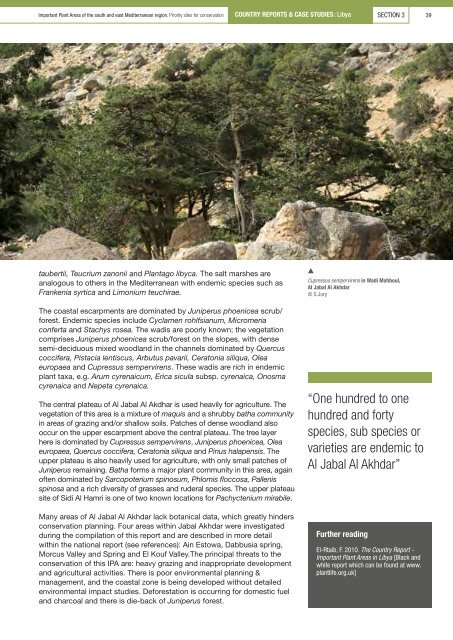Important Plant Areas of the south and east Mediterranean ... - IUCN
Important Plant Areas of the south and east Mediterranean ... - IUCN
Important Plant Areas of the south and east Mediterranean ... - IUCN
Create successful ePaper yourself
Turn your PDF publications into a flip-book with our unique Google optimized e-Paper software.
<strong>Important</strong> <strong>Plant</strong> <strong>Areas</strong> <strong>of</strong> <strong>the</strong> <strong>south</strong> <strong>and</strong> <strong>east</strong> <strong>Mediterranean</strong> region. Priority sites for conservation<br />
COUNTRY REPORTS & CASE STUDIES : Libya<br />
SECTION 3<br />
39<br />
taubertii, Teucrium zanonii <strong>and</strong> <strong>Plant</strong>ago libyca. The salt marshes are<br />
analogous to o<strong>the</strong>rs in <strong>the</strong> <strong>Mediterranean</strong> with endemic species such as<br />
Frankenia syrtica <strong>and</strong> Limonium teuchirae.<br />
The coastal escarpments are dominated by Juniperus phoenicea scrub/<br />
forest. Endemic species include Cyclamen rohlfsianum, Micromeria<br />
conferta <strong>and</strong> Stachys rosea. The wadis are poorly known; <strong>the</strong> vegetation<br />
comprises Juniperus phoenicea scrub/forest on <strong>the</strong> slopes, with dense<br />
semi-deciduous mixed woodl<strong>and</strong> in <strong>the</strong> channels dominated by Quercus<br />
coccifera, Pistacia lentiscus, Arbutus pavarii, Ceratonia siliqua, Olea<br />
europaea <strong>and</strong> Cupressus sempervirens. These wadis are rich in endemic<br />
plant taxa, e.g. Arum cyrenaicum, Erica sicula subsp. cyrenaica, Onosma<br />
cyrenaica <strong>and</strong> Nepeta cyrenaica.<br />
The central plateau <strong>of</strong> Al Jabal Al Akdhar is used heavily for agriculture. The<br />
vegetation <strong>of</strong> this area is a mixture <strong>of</strong> maquis <strong>and</strong> a shrubby batha community<br />
in areas <strong>of</strong> grazing <strong>and</strong>/or shallow soils. Patches <strong>of</strong> dense woodl<strong>and</strong> also<br />
occur on <strong>the</strong> upper escarpment above <strong>the</strong> central plateau. The tree layer<br />
here is dominated by Cupressus sempervirens, Juniperus phoenicea, Olea<br />
europaea, Quercus coccifera, Ceratonia siliqua <strong>and</strong> Pinus halapensis. The<br />
upper plateau is also heavily used for agriculture, with only small patches <strong>of</strong><br />
Juniperus remaining. Batha forms a major plant community in this area, again<br />
<strong>of</strong>ten dominated by Sarcopoterium spinosum, Phlomis floccosa, Pallenis<br />
spinosa <strong>and</strong> a rich diversity <strong>of</strong> grasses <strong>and</strong> ruderal species. The upper plateau<br />
site <strong>of</strong> Sidi Al Hamri is one <strong>of</strong> two known locations for Pachyctenium mirabile.<br />
Many areas <strong>of</strong> Al Jabal Al Akhdar lack botanical data, which greatly hinders<br />
conservation planning. Four areas within Jabal Akhdar were investigated<br />
during <strong>the</strong> compilation <strong>of</strong> this report <strong>and</strong> are described in more detail<br />
within <strong>the</strong> national report (see references): Ain Estowa, Dabbusia spring,<br />
Morcus Valley <strong>and</strong> Spring <strong>and</strong> El Kouf Valley.The principal threats to <strong>the</strong><br />
conservation <strong>of</strong> this IPA are: heavy grazing <strong>and</strong> inappropriate development<br />
<strong>and</strong> agricultural activities. There is poor environmental planning &<br />
management, <strong>and</strong> <strong>the</strong> coastal zone is being developed without detailed<br />
environmental impact studies. Deforestation is occurring for domestic fuel<br />
<strong>and</strong> charcoal <strong>and</strong> <strong>the</strong>re is die-back <strong>of</strong> Juniperus forest.<br />
Cupressus sempervirens in Wadi Mahboul,<br />
Al Jabal Al Akhdar<br />
© S.Jury<br />
“One hundred to one<br />
hundred <strong>and</strong> forty<br />
species, sub species or<br />
varieties are endemic to<br />
Al Jabal Al Akhdar”<br />
Fur<strong>the</strong>r reading<br />
El-Rtaib, F. 2010. The Country Report -<br />
<strong>Important</strong> <strong>Plant</strong> <strong>Areas</strong> in Libya [Black <strong>and</strong><br />
white report which can be found at www.<br />
plantlife.org.uk]

















